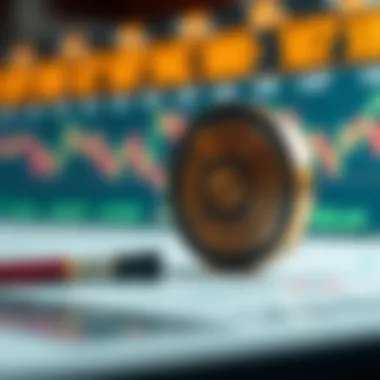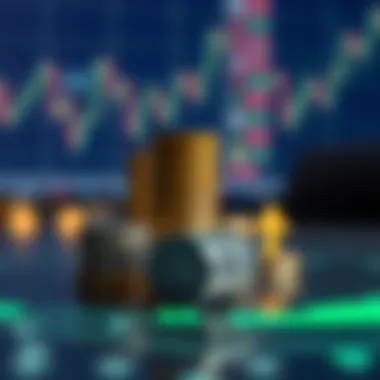Understanding Stock Futures and Their Impact on Investing


Intro
Understanding stock futures can feel like unraveling a complex jigsaw puzzle. For those venturing into the stock market, grasping their mechanics is crucial. Stock futures are essentially agreements to buy or sell a stock at a predetermined price on a set date in the future. They can serve various purposes, be it hedging against market downturns or speculating on price movements. However, the details can get murky without a solid foundation in the underlying concepts that govern these financial instruments.
In various ways, stock futures have altered how investors approach the market. They bring a unique juxtaposition of risk and opportunity, which is why understanding them is a necessity for informed decision-making. This article will demystify stock futures by diving into essential definitions, the types available, strategies for trading, the risks involved, and how investors can leverage these tools effectively—all designed for financial enthusiasts eager for knowledge and understanding.
As we progress through the sections, you'll gain insights that could potentially enhance your portfolio and refine your trading strategies, making your financial journey a bit clearer. Let's get started.
Preamble to Stock Futures
The world of finance is intricate, with various instruments and strategies floating around. Among them, stock futures hold a significant place. Understanding stock futures is not just for seasoned traders; it is crucial for anyone who wants to grasp broader financial concepts. These contracts allow investors to lock in prices of stocks for future transactions, creating a solid avenue for hedging and speculation alike.
Investors who delve into this market can benefit in multiple ways. Firstly, they gain the ability to hedge against potential price declines. If you own shares and anticipate a dip, selling futures can protect you from losses. Secondly, stock futures offer leverage, which means you can control a substantial amount of stock with a smaller initial investment. This opens the door for potentially higher returns, albeit with increased risk.
However, it's not all rainbows and sunshine. Engaging with stock futures requires careful consideration. The complexities involved can lead to significant financial repercussions if one is not fully informed. Therefore, in this article, we'll unravel the essence of stock futures, so you can navigate the complexities more confidently.
Definition of Stock Futures
Stock futures are agreements to buy or sell a specific amount of stock at a predetermined price on a set future date. Imagine these contracts as your ticket to the future; you are locking in a price today for a transaction that will occur later. This arrangement can protect investors from market fluctuations and price movements that might occur between the contract's inception and its settlement date.
For instance, if a trader believes that a particular stock will increase in price, they may buy futures contracts in anticipation. Conversely, if they think it will decline, they might sell futures. The flexibility and predictability that stock futures provide are invaluable for many market participants.
Historical Context
Historically, the foundation of stock futures can be traced back to the early 1980s. The Chicago Mercantile Exchange was what one might call the trailblazer by offering stock index futures, which allowed investors to gain exposure to entire stock market sectors rather than individual stocks.
Over time, this concept evolved further. With technological advancements and changing market dynamics, stock futures became more widely accessible to individual investors, not just institutional players. The adoption grew, particularly with the onset of online trading platforms in the late '90s, paving the way for stock futures as a popular trading vehicle.
Today, stock futures are an integral part of modern finance, offering diverse opportunities for hedging, speculation, and risk management, showcasing the ongoing evolution of financial derivatives.
Fundamentals of Stock Futures
Understanding stock futures isn't just for Wall Street moguls. It's essential for anyone looking to navigate the complex waters of modern investing. By tapping into the fundamentals, investors can grasp how these financial instruments work, the benefits they offer, and the implications they have on broader market dynamics. Whether you’re a seasoned trader or a newcomer, a solid foundation in stock futures can significantly enhance your decision-making process.
How Stock Futures Operate
Stock futures are essentially contracts to buy or sell a specific stock at a predetermined price on a specified future date. Now, you might be wondering how this works in a practical sense. Let's break it down.
When you buy a stock future, you're entering into an agreement to purchase stock in the future, often leveraging your capital. For example, if you believe that the price of Tesla is going to rise, you might buy a Tesla stock future at $700, expecting the price to jump to $800 by the contract's expiration. Conversely, someone might sell a future, betting on a decline.
The mechanics behind this involve several key elements:
- Leverage: Futures allow investors to control large amounts of stock with a relatively small initial investment. This kind of leverage can amplify gains, but it also poses risks.
- Margin Requirements: Investors are required to maintain a certain amount of equity in their accounts, often around 5-10% of the total value of the futures contract.
- Daily Settlement: Futures contracts are settled daily. This means if the price moves in your favor, your account increases accordingly. If it moves against you, losses can accumulate quickly.
So if you’re looking to delve into the world of stock futures, understanding these operational mechanics is key.
Key Terminology
Navigating the stock futures landscape requires familiarity with specific terminology that can seem like another language to the uninitiated. Knowing these terms will give you a clearer picture of what’s at stake and the nuances involved in trading.
- Contract Size: The amount of what you're trading in a futures contract. For most stock futures, this relates directly to how many shares you’ll be dealing with.
- Expiration Date: This is the date when the futures contract is settled. Understanding this is crucial because any miscalculation related to timing can lead to unexpected outcomes.
- Mark-to-Market: This principle entails adjusting the investment account to reflect current market values, ensuring that profits and losses are recognized in real time.
- Hedging: A risk management strategy used to offset potential losses in investments. This is particularly relevant for those using futures to protect their existing holdings.
- Speculation: The act of making trades with the expectation of a profit based on future price movements.
Comprehending these terms will not only help in practical trading situations but will also enable you to communicate effectively with others in the market.
"It's not just about buying low and selling high. It's about understanding the landscape."
To conclude, having a firm grasp of the fundamentals of stock futures can pave the way for informed trading decisions. It sets the stage for exploring more complex strategies and identifying opportunities that might otherwise go unnoticed. Absorbing this foundational knowledge may reveal pathways towards significant financial insights and potential investment gains.
Types of Stock Futures
When it comes to trading in stock futures, understanding the different types is crucial. Each type serves specific purposes for market participants, whether they are hedgers, speculators, or institutional investors. By diving into the various categories of stock futures, investors can better align their strategies with market movements and their personal financial goals.
Equity Futures
Equity futures are contracts that allow traders to buy or sell a specific stock at a predetermined price at a future date. The primary allure of equity futures lies in their capacity to provide significant leverage. For instance, imagine a trader believes that the stock of Tesla will skyrocket in the coming weeks. By purchasing equity futures, that trader can amplify their potential returns without needing to invest the full price of the underlying stock up front.
Investors delve into equity futures not only for speculation but also for hedging purposes. For example, if an investor owns shares of Apple and is worried about a short-term downturn, they might sell equity futures as a form of insurance. This way, if Apple’s stock price drops, the losses in the equity position could be offset by gains in the futures contract.
Index Futures
Index futures are another significant type of stock futures that represents a broader market or sector. Instead of focusing on individual stocks, these contracts mirror the performance of stock indices like the S&P 500 or the Dow Jones Industrial Average. Traders or institutional investors often prefer index futures for several reasons.
Firstly, they provide a way to gain exposure to an entire market segment without requiring investments in each component stock. Index futures also tend to be less volatile compared to individual equities, offering a slightly safer playing field. For instance, if a trader anticipates that the market as a whole will rise, they can buy index futures to potentially profit from that upward trend.


Moreover, these futures can be used for hedging as well. An investor with a portfolio heavily weighted in technology stocks may choose to sell index futures to hedge against market drops. This strategy can be especially useful using diversification, as it can offset losses in specific sectors when market conditions fluctuate.
Sector Futures
Sector futures allow traders to focus on specific segments of the economy. For instance, futures contracts that involve the healthcare or technology sector give an opportunity to capitalize on particular trends affecting those industries. This type of futures trading can be beneficial for those who have a granular understanding of specific industries and wish to leverage their insights.
Let’s say an investor identifies robust growth potential in renewable energy. By purchasing sector futures tied to clean energy companies, that investor positions themselves to profit from that anticipated growth. Alternatively, suppose an investor believes that the oil sector is due for a downturn due to increasing regulatory pressures. They might opt to sell futures based on the sector to mitigate prospective losses.
Sector futures not only provide excellent opportunities for speculation but can also serve as instruments to hedge broader market risks.
In summary, having a grasp of these types—equity, index, and sector futures—equips traders and investors with necessary insights to navigate the stock futures market efficiently. Recognizing the nuances and strategies associated with each type enhances decision-making and ultimately contributes to improving overall investment performance. The ability to choose the right type of stock futures based on one’s investment objectives is what can set a successful investor apart from the rest.
Participants in the Stock Futures Market
Understanding who plays a role in the stock futures market is essential. This market is not just a collection of transactions; it’s a vibrant ecosystem with various participants, each with unique objectives and strategies. The interaction between these participants shapes the market dynamics, influences pricing, and contributes to the overall health of financial systems. In this section, we will dive into two main types of participants: hedgers and speculators. Their motivations and actions offer significant insights into how the futures market functions.
Hedgers
Hedgers represent a segment of market participants looking to reduce risk rather than seeking profit. They often come from industries that are directly affected by price fluctuations in underlying assets. For instance, a farmer growing wheat can enter a futures contract to lock in a price before harvest time. This strategy protects against price drops that could occur by the time the crop is ready for sale.
Hedging essentially serves as a form of insurance. By entering into a futures contract, hedgers can stabilize their income and make more accurate financial forecasts. Some key points regarding hedgers include:
- Risk Management: They utilize futures contracts to mitigate the risk of adverse price movements.
- Market Insight: Their positions can provide valuable information about supply and demand dynamics in specific sectors.
- Stability in Operations: By locking in prices, businesses can plan better without worrying about market volatility.
Hedgers typically take positions that match their existing exposure in the physical market. For instance, an airline may enter futures contracts on jet fuel to secure prices against unexpected spikes. This strategy allows them to manage costs and ensure more predictable profit margins.
Speculators
On the flip side, speculators are the risk-takers of the stock futures market. Their primary motivation is to profit from price fluctuations rather than safeguard against them. They often have a deep understanding of market trends and may rely on technical or fundamental analysis to make decisions. Speculators can range from large institutional investors to individual day traders. Here are some aspects of speculators:
- Market Liquidity: They add liquidity to the market, making it easier for hedgers to enter and exit positions without a hitch.
- Price Discovery: Their activities contribute to the process of price discovery, helping establish fair market values based on supply and demand.
- Short-term Focus: Speculators often have a more aggressive trading style and may hold positions for short periods, capitalizing on short-term price movements.
A classic example is a hedge fund that bets on the movement of an index future based on economic data releases. If they anticipate positive news, they might take a long position, hoping to profit when prices rise. Conversely, they might short an index if they predict negative outcomes. While hedgers seek protection, speculators thrive on uncertainty, aiming to capitalize on the very risks that hedgers work to manage.
"Speculators drive the market, while hedgers stabilize it; both are essential for a balanced trading environment."
Mechanism of Trading Stock Futures
Trading stock futures is not just a whimsical endeavor for market thrill-seekers; it's a systematic strategy that requires keen understanding of various aspects. The market mechanics underpinning these futures contracts are pivotal for investors aiming for effective entry and exit strategies. When engaging with stock futures, recognizing the mechanics helps in navigating the volatility and potential opportunities that may arise.
Understanding how this framework operates can make a significant difference between profits and losses. It sheds light on the ways in which market orders, limit orders, and other types interact through platforms such as the Chicago Mercantile Exchange or the Intercontinental Exchange. Just like a well-oiled machine, every cog in this mechanism has its purpose, influencing broader market dynamics.
Order Types
In the world of stock futures, there are several order types that traders should familiarize themselves with. Each of these orders serves a distinct function and can optimize trading strategies based on the market conditions at a given moment.
- Market Orders: These are straightforward requests to buy or sell a futures contract at the current market price. Ideal for simplicity, market orders execute immediately, ensuring that traders capitalize on current prices without delay, but at the risk of unexpected slippage, particularly in volatile markets.
- Limit Orders: This order type permits traders to specify a price at which they wish to buy or sell a contract. A limit order will only execute when the market reaches that specified price or better. It's the safety net for those traders who have a particular price point in mind, but it does come with the risk of non-fulfillment if the market doesn't reach those thresholds.
- Stop-Loss Orders: Designed to mitigate risks, stop-loss orders automatically trigger a sale when a futures contract reaches a predetermined price level. This type of order provides some cushion against excessive losses during sharp, unfavorable moves in the market, acting almost like an insurance policy against volatility.
- Stop-Limit Orders: A hybrid strategy, stop-limit orders become a limit order when the stop price is reached. It allows traders to maintain a degree of control while still providing a mechanism to exit positions but carries the risk of not executing if the market moves rapidly.
Understanding these various order types empowers traders too manage their trades more effectively, adapting their strategies to the pulse of the market.
Settlement Process
Once the trades are placed and positions established, it's crucial to comprehend how the settlement process unfolds. The settlements of stock futures contracts dictate the effective transfer of assets and profits between market participants.
- Physical Settlement: This is where the actual underlying asset is exchanged. In equities, this might mean that, on the contract's expiration date, the buyer would receive shares of the stock. It's essential for those who want tangible ownership of the assets.
- Cash Settlement: More common in many futures contracts, cash settlement circumvents the physical exchange of the underlying asset. Instead, the net difference between the contract price and the market price is settled in cash. This method reduces the complexities of logistics, especially in commodities or instruments that are less manageable physically.
- Daily Mark-to-Market: Each day, gains or losses are calculated, ensuring that any fluctuations in the futures contract are immediately accounted for. This daily adjustment helps to maintain the integrity of collateral and margin requirements, ensuring that the traders can meet their obligations in a timely manner.
Understanding the settlement process underlies not just the operational aspect but also the financial health of trading activities. Knowing how trades settle reveals potential liquidity constraints and risk exposure, essential insights for any serious investor.
“In trading, it’s not about how much you make, but about how much you learn through the process.”
To encapsulate, grasping the mechanisms of trading stock futures lays the groundwork for informed decision-making in an ever-evolving market landscape. By mastering order types and the intricacies of the settlement process, investors can tailor their trading strategies to align well with their financial goals.
Risks Associated with Stock Futures
When diving into the world of stock futures, understanding the associated risks is crucial. Trading these contracts might offer strategic advantages for investors, but it comes with a fair share of uncertainties. This section will explore the importance of recognizing and managing the risks tied to stock futures, which can significantly impact investment outcomes.
Benefits of Understanding Risks
Grasping the risks involved can help investors make informed decisions, construct comprehensive risk management strategies, and ultimately protect their capital. Whether you're a hedger looking to mitigate losses or a speculator aiming to capitalize on price fluctuations, acknowledging these risks lays the foundation for a well-balanced approach to trading.
Market Risk
Market risk is perhaps the most prominent risk associated with trading stock futures. It encompasses the possibility of an investor experiencing losses due to unfavorable market movements. Stocks, just like the weather, can change fast and unexpectedly. Factors contributing to market risk include economic shifts, political events, and even natural disasters.
For example, let’s say you bought futures contracts on a tech stock, anticipating its price will rise due to positive earnings reports. However, if a significant cybersecurity breach occurs, not only will the stock plummet, but your futures position will also follow suit, increasing the potential losses.


Key Elements of Market Risk
- Volatility: Market volatility can create significant price swings, leading to possible gains or losses in a short time.
- Liquidity: In less liquid markets, slippage can occur. This is when the expected price of a trade differs from the actual price due to a lack of buyers or sellers.
- Systematic Risk: This refers to the chance that the entire market will decline, impacting all stocks regardless of their individual performance.
"Investors should be prepared for sudden market changes—navigating through turbulent waters is never easy."
Leverage Risk
Leverage risk arises from the use of borrowed funds to increase the potential return on investment. In stock futures, leveraging allows traders to control large positions with a relatively small amount of capital. While this can amplify gains, it also magnifies losses.
Suppose you decide to trade stock futures with a leverage of 10:1. If the market moves in your favor, your profits can skyrocket. Conversely, if the market turns against you, the losses can swiftly outpace your initial investment.
Considerations around Leverage Risk
- Margin Calls: Traders need to maintain a minimum balance in their accounts. Falling below this threshold due to declining asset prices can trigger margin calls, requiring immediate additional funds.
- Risk of Total Loss: Utilizing high leverage can lead to total account wipeout if the market takes a sharp downturn, emphasizing the need for careful risk management practices.
- Emotional Stress: The pressure of trading on leverage can weigh heavily on investors. The fear of losing more than they can afford might cloud judgment, leading to rash decisions.
Understanding these aspects is pivotal in developing a robust, informed approach to futures trading.
Strategic Approaches to Trading Stock Futures
A strategic approach can lead to improved decision-making by anchoring investors in a clear framework for their trading activities.
Long Futures Position
Taking a long futures position means that an investor is betting on the price of an asset rising. This strategy primarily serves those who foresee bullish market scenarios. By entering into a long position, a trader agrees to buy the underlying asset at a predetermined price at a specified future date. If the market swings favorably, meaning the asset’s price climbs higher than the agreed-upon futures price, they can either sell the futures contract for a profit or take delivery of the asset itself.
Benefits of Long Positions:
- Potential for Significant Gains: If the asset indeed rallies, the profit margin can be substantial.
- Hedging Against Short Selling: Long positions can offset short-sold assets, effectively balancing overall risk.
- Speculating on Growth: Ideal for investors who are bullish about a specific stock or market trend.
However, potential risks must not be ignored. A sudden downturn can lead to losses that exceed initial investments, so risk mitigation strategies, like setting stop-loss limits, are crucial.
"Investment is not just about money; it's about managing risk and aligning strategy with personal financial goals."
Short Futures Position
Conversely, a short futures position represents a bear market stance. Here, the trader expects the price of the underlying asset to decline. A short position obliges the trader to sell the asset at a predetermined price, hoping to purchase it back at a lower price in the future. This approach can be a double-edged sword; while it can indeed yield profits when forecasts are correct, the risks can be equally staggering.
Advantages of Short Positions:
- Profit from Market Downturns: Enables capitalizing on falling prices, creating opportunities in bearish markets.
- Loss Mitigation: Shorting can provide a cushion against losses in a portfolio that may be long on other investments.
- Diversifying Strategy: Adding a defensive layer to one's trading strategy can help stabilize returns during unpredictable market cycles.
Just as in long positions, the prospective profits from short selling can vanish just as quickly as they appear, particularly in volatile markets. The prospect of unlimited losses fundamentally alters the risk profile and demands a more cautious approach.
Analytical Tools for Futures Trading
In the complex world of stock futures, having a solid grasp on analytical tools can make all the difference between a successful trade and a costly blunder. These tools allow investors to make informed decisions, measuring price trends and market movements effectively. Whether you are a seasoned trader or someone just dipping your toes into the futures waters, understanding these analytical tools is vital to stay ahead of the game.
Analytical tools serve multiple purposes. They help in identifying pricing trends, gauging market sentiment, and ultimately predicting movements in futures prices. Their importance cannot be emphasized enough in making sound trading decisions. Employing these tools, traders can sharpen their strategies and approach in a methodical way that minimizes uncertainty.
Technical Analysis
When talking about analytical tools, technical analysis is often the star of the show. This approach involves scrutinizing past market data, especially price and volume, to predict future price behavior. To put it simply, it's like pouring through historical records to find patterns — trends that have repeated themselves over time.
Here are some key elements of technical analysis:
- Charts: Line charts, bar charts, and candlestick charts are fundamental in visualizing price movements. These graphical tools provide insights into where prices have been and where they might be going.
- Indicators: Metrics like Moving Averages or the Relative Strength Index (RSI) help traders understand momentum, whether a stock is overbought or oversold, or identifying potential reversal points.
- Volume Analysis: Keeping an eye on trading volume provides clues about the strength of a trend. A price movement accompanied by high volume is generally considered more significant than one with low volume.
The beauty of technical analysis lies in its adaptability. It's not a one-size-fits-all solution; traders often mix and match various indicators to create a customized toolkit that suits their unique trading style.
Technical analysis lays the groundwork for defining market psychology, which can be crucial in futures trading.
Fundamental Analysis
While technical analysis focuses on the numbers, fundamental analysis digs deeper into the underlying factors that might influence a stock's price. This approach considers elements such as a company's earnings, economic indicators, or even external events like new regulations or geopolitical tensions.
Fundamental analysis can be broken down into several areas of focus:
- Earnings Reports: Regular updates on a company's profits or losses can significantly influence stock futures. Positive earnings often lead to higher stock prices, while disappointing results can do the opposite.
- Economic Indicators: Reports on employment figures, GDP growth, or inflation often sway overall market sentiment and hence affect stock futures. Keeping tabs on these indicators provides a larger context in which individual stocks operate.
- Market News: Events such as mergers, acquisitions, or policy changes can dive a stock's price up or down. Investors need to stay informed about such happenings to position themselves wisely in the market.
Fundamental analysis requires a keen understanding of the broader economic landscape and a skill for interpreting how various factors impact stock prices. It’s not just about reading numbers; it’s about reading the market.
The blend of both technical and fundamental analysis can create a robust strategy for futures trading. By employing these analytical tools wisely, investors can make choices grounded in research rather than mere speculation. Studying these elements forms a solid foundation for navigating the stock futures landscape.


The Role of Margin in Stock Futures
Margins play a fundamental role in the trading of stock futures by acting as a financial safety net for both traders and exchanges. Understanding margins is crucial for anyone venturing into this complex landscape, as they define the amount of money an investor must commit to enter into a futures contract. They also protect against potential losses incurred during periods of volatility. On the whole, having a firm grasp on how margins operate can significantly influence one's strategy and risk management in futures trading.
Initial Margin Requirements
When an investor enters into a futures contract, they are required to make an initial payment known as the initial margin. This amount is typically set by futures exchanges and usually represents a fraction of the total contract value. The purpose is straightforward: it ensures that traders have sufficient skin in the game to cover potential losses before they occur.
In most cases, the initial margin can range anywhere from 5% to 15% of the value of the contract. For example, if you were to buy a stock futures contract worth $100,000 and the initial margin requirement is 10%, you would need to deposit $10,000 to hold that position. This requirement can vary between different contracts and exchanges, reflecting factors like underlying volatility or market conditions.
Moreover, it's essential to recognize that the initial margin includes various considerations:
- Creditworthiness: Brokers may adjust initial margins based on a trader's history and financial stability.
- Volatility of the Asset: More volatile assets may require higher initial margins to limit risk.
- Contract Size: Larger contracts typically call for greater margins.
A common misconception is that a large initial margin equates to lower risk. This isn't fully accurate. While a higher initial margin reduces potential exposure, it doesn’t change underlining market volatility, which may pose risks despite the margin size.
Maintenance Margin
After positioning oneself in the futures market, the maintenance margin comes into play. This is the minimum amount an investor must maintain in their margin account to keep their position open. If the value of the underlying asset falls significantly, leading to a decline in account equity below this threshold, a margin call is triggered. This means the investor must inject more funds into their account to meet the maintenance margin requirement.
Typically, the maintenance margin is set lower than the initial margin, allowing for some fluctuation in the asset's price without triggering a margin call. However, this can feel like a double-edged sword. If an investor does not have adequate liquidity or fails to respond quickly to a margin call, they could find themselves forced to liquidate their position at an unfavorable price.
Some salient points about maintenance margins include:
- Market Dynamics: Rapid price swings can induce margin calls, so being aware of current market conditions is vital.
- Brokerage Policies: Depending on the brokerage, maintenance margin requirements may differ, so it's important to check those specifics before trading.
- Best Practices: Many seasoned traders opt to keep their margin accounts well above the maintenance level to avoid issues arising from sudden market changes.
In summary, margins are not just technicalities in stock futures; they represent a vital mechanism that affects both trading strategy and risk management. By understanding initial margin requirements and maintenance margins, traders can better navigate the complex waters of futures trading, preparing them to respond effectively to the demands of the market.
Regulatory Framework Governing Stock Futures
The regulatory framework governing stock futures is paramount for ensuring orderly functioning and transparency in financial markets. This framework instills confidence among investors by providing a structured environment where transactions are conducted fairly. A deep dive into how regulations operate can unveil the intricate tapestry that underpins the stock futures market.
Regulatory Bodies
In the realm of stock futures, several regulatory bodies play a crucial role. One of the most significant players is the Commodity Futures Trading Commission (CFTC) in the United States. Established to protect market participants from fraud, manipulation, and abusive practices, the CFTC oversees the trading of futures and options. Their mandate extends to ensuring that the exchanges maintain integrity and fairness.
In addition to the CFTC, exchanges like the Chicago Mercantile Exchange (CME) and the Intercontinental Exchange (ICE) have internal regulations that govern trading practices. These organizations set their own rules to enhance market surveillance and compliance, which often align with federal regulations but are tailored to address specific market conditions.
Across the pond, the European Securities and Markets Authority (ESMA) serves a similar purpose in Europe. It ensures that securities markets function effectively while protecting investors and promoting stable financial systems.
The regulations set forth by these bodies hinge on key aspects such as:
- Market Surveillance: Regular monitoring to prevent market manipulation.
- Reporting Requirements: Transparency in trade reporting and data dissemination.
- Investor Protection Measures: Rules designed to safeguard traders and investors from unethical practices.
Compliance Guidelines
Compliance is the name of the game in the world of stock futures. Thus, understanding the compliance guidelines is essential for anyone looking to trade in this arena. These guidelines consist of rules that traders and firms must follow to avoid penalties and ensure smooth operations within the stock futures landscape.
Here are a few important compliance considerations:
- Registration Requirements: Traders and firms typically need to register with regulatory bodies to operate. This registration process helps ensure that only qualified and vetted entities engage in futures trading.
- Regular Audits and Reports: Many regulatory bodies require firms to submit periodic reports and undergo audits to verify compliance with established rules. Failing to meet these requirements can lead to fines or suspension from trading.
- Conduct Standards: All entities involved must adhere to ethical conduct standards, which include avoiding insider trading and providing clients with fair terms of service.
In summary, the regulations governing stock futures aren’t merely bureaucratic hurdles but vital systems designed to uphold market integrity and protect investors. Understanding these regulations equips market participants with the necessary knowledge to navigate stock futures effectively and responsibly.
"Regulatory frameworks are the backbone of trust in financial markets, ensuring every trader can engage with confidence."
For deeper insights, refer to the following resources:
- CFTC
- ESMA
- Chicago Mercantile Exchange \n- Intercontinental Exchange \n- For additional regulatory compliance resources, explore government domains like *.gov and educational institutions such as *.edu.
Closing Thoughts on Stock Futures
The world of stock futures is not just a labyrinth of numbers and charts; it's a dynamic space blending risk, strategy, and opportunity. As we wrap up our exploration of stock futures, it’s crucial to reflect on the elements that contribute to their significance in today’s financial markets.
Evaluating Performance
When it comes to assessing how well your stock futures trades have fared, you need to look at several metrics. Here’s where the rubber meets the road. Some key performance indicators include:
- Return on Investment (ROI): This measures how much profit your investment has generated relative to its cost. It’s an essential metric for any investor wanting to gauge the effectiveness of their investments.
- Volatility Assessment: Understanding how the price of a stock future fluctuates can give you insight into potential gains and losses. Higher volatility can mean higher risk but also potential for higher returns.
- Strike Price Analysis: Your chosen strike price will directly impact the performance of your futures. Ideally, comparing actual prices to your strike price can unveil whether you made an informed choice.
- Market Sentiment Indicators: These can often provide a qualitative perspective on how the broader market feels about particular stock futures. Is the buzz positive or negative? Keeping your ear to the ground here is critical.
To accurately evaluate performance, it may also be helpful to keep a trading journal. Document your strategies, outcomes, and market conditions. This isn’t just busywork; it’s a way to learn from both your triumphs and mistakes.
Future Trends
Looking ahead, stock futures are likely to evolve alongside technological advancements and shifting market dynamics. Several trends appear poised to shape the landscape:
- Increased Use of Algorithms: Automated trading using sophisticated algorithms is gaining traction, driven by data analysis and market simulations. Investors are relying on technology to make swift decisions, and the interest in these tools only continues to rise.
- Sustainability and Ethical Investing: There’s steady growth in ESG (Environmental, Social, Governance) investing. Futures tied to sustainable projects may capture the attention of investors looking to align their financial goals with ethical considerations.
- Global Market Integration: As markets become more interconnected, investors are presented with opportunities to engage in emerging markets through futures. This adds another layer of complexity but opens doors for unprecedented returns.
- Regulatory Changes: Keeping an eye on legislation affecting derivatives trading is crucial. Regulations can shift market dynamics significantly, influencing liquidity or even accessibility of certain futures.
In summary, stock futures offer a complex but rewarding landscape for investors committed to understanding their nuances. The effectiveness of your investment strategy hinges not just on knowledge, but on an adaptable mindset in the face of rapid market changes. As the saying goes, "the only constant in life is change"; therefore, staying informed is not just an option, it's a necessity.















